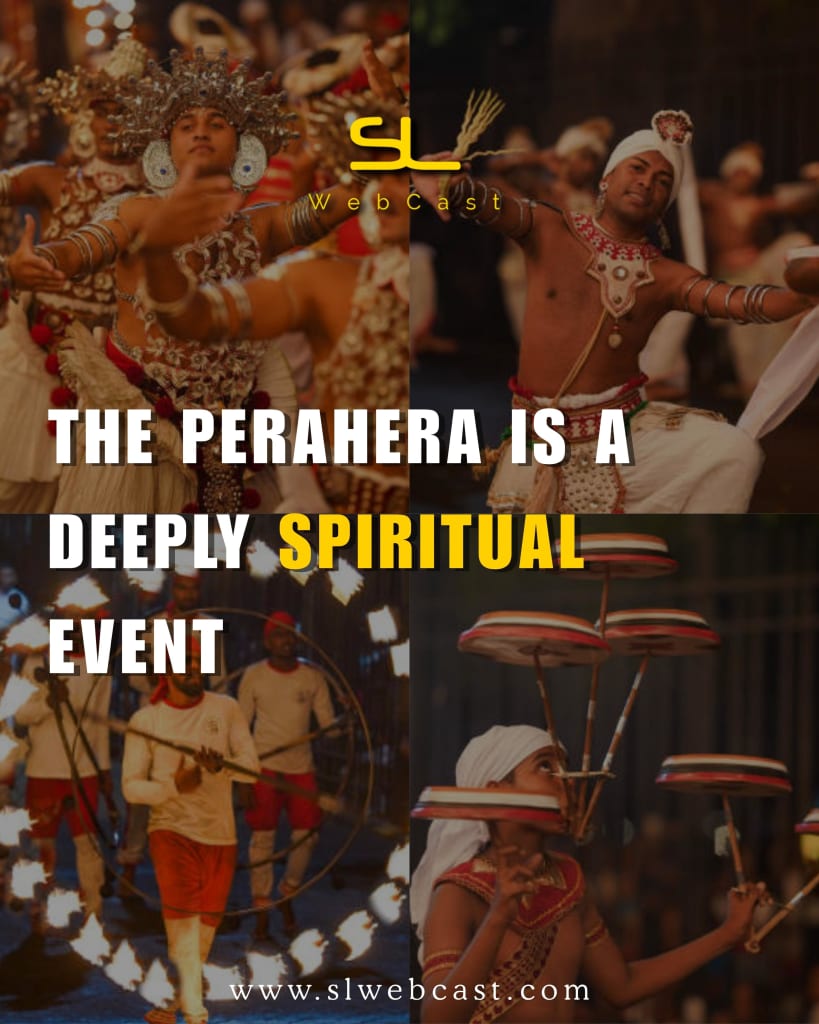As the sun starts to dip behind the hills, and the air begins to pulse from distant drums, with torches lining the streets, the city of Kandy awakens.
Majestic elephants, with gleaming ivory tusks, clad in glimmering robes, dancers from all over the island, gliding around in blurs of vivid colours, fire dancers twirling like spirits, as thousands of eyes-local and traveller alike turn toward the Sacred tooth relic- this is the Kandy Esala Perahera. A breathtaking display of heritage, faith and culture.

A Glimpse into a Glorious Past
The Esala Perahera is a procession that can be traced back to the 3rd and 4th Century, when the Sacred Tooth Relic was first brought to Sri Lanka from India in the 4th Century, approximately 800 years after the passing of Lord Buddha.
The Sacred Tooth Relic had been in possession of the king at the time, King Keerthi Sri Rajasinghe. But after the fall of the Kandyan Kingdom in 1815, it was entrusted to the Maha Sangha (the Buddhist monastic order) who with the absence of a monarch appointed a Diyawadana Nilame (Chief lay custodian) to oversee its administrative functions.
At its core, the Perahera is a deeply spiritual event. It is believed to be a ritual done to the deities of four ancient devales (shrines): Natha, Vishnu, Katharagama and Pattini. Not only does it honor the Sacred Tooth Relic housed at the Sri Dalada Maligawa (Temple of the Tooth), but is an offering to the four divine guardians asking for blessings, guidance and particularly a good harvest and timely rain.

A Festival Rooted in Faith
The procession consists of the Kumbal Perahera, the Randoli Perahera, Kap Situveema/Kapa, Diya Kapeema and the day Perahera.
It commences with Kap Situveema which is the act of planting a branch of a young Jack fruit tree. The sacred branch is blessed and split into four parts, which are then planted at the four devalas (shrines). This ceremony is believed to evoke blessings from the four guardian deities to ensure the Perahera takes place without any incident.
The Kumbal Perahera is the first of the processions. It drives away evil spirits and negative energy. It is then followed by Peraheras from the four devalas that converge in front of the Dalada Maligawa (Temple of the Tooth).
Then comes the Randoli Perahera. Randoli refers to the palanquins used to carry queens. This part of the procession is considered the best part of the entire event. The four devalas carry their own decorated palanquins and are usually last in the procession.
The Esala Perahera then concludes with diya kapeema. It is a traditional water cutting ceremony. The water is considered sacred and is believed to get rid of evil. After the ceremony, the four Peraheras join the Maligawa Perahera and parade around Kandy-the day Perahera-before the Maligawa Perahera enters the Maligawa and the remaining Peraheras enter their respective devalas bringing an end to the annual Esala Perahera.
The Procession: A Living Work of Art

Apart from the spiritual aspect of the Perahera, its visual nature also leaves a lasting impact, from the elephants that joyously glide through the streets to the dancers that twirl and leap into the night.
The Esala Perahera display is one of extravagance. Consisting of the Magul Bera-the blowing of the conch at the commencement of festivities, whip crackers-used to announce the arrival of the perahera, Padampeliya-a fire dance, Kulu Natuma-a dance done to celebrate a rich harvest, Ves Natuma, Kandyan dancers, drummers, trumpeters, traditional dancers, Kavadi and so much more stretching on far beyond the eye can see. Each step, each rhythm, whispering a story of devotion, discipline and identity. And the energy? Unmistakable. You don’t just watch the Perahera, you’re pulled into it.
Planning Your Visit
The Perahera usually takes place during the month of July or August (the month of Esala). The final nights, especially the Randoli Perahera are the most elaborate and crowded. When attending make sure to:
- Book early- The hotels in Kandy tend to fill up quickly. The official website also sells tickets for various storefronts.
- Arrive Early- By the time afternoon approaches, police will start setting up check points and crowds will start gathering. Make sure you get a good view before crowds build.
Be Aware- With great crowds comes theft and the possibility of being pickpocketed. Make sure you only carry your necessities and keep an eye on them throughout. - Prepare in Advance-Once the Perahera has concluded, the chances of finding an unoccupied driver is extremely low. So make sure you have a vehicle prepared to escort you if you live outside the city or beyond walking distance.
- Also be informed that the farther you are from the Temple, the longer it’ll take the Perahera to reach you.
- And finally enjoy the Perahera while being respectful.
The Festival That Lives in the Soul

From ancient rituals whispered down through generations, to the clamor of modern acclaim, the Kandy Esala Perahera is more than just a festival-it’s the soul of a nation on proud, public display. Whether you find yourself watching from afar with wide-eyed fascination or pressed against the railings on a hot, humid Kandy night, one thing is certain: the Perahera leaves a lasting memory in your heart.


